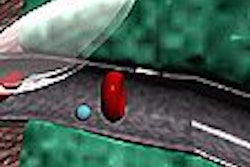Diagnosis is especially difficult in acute abdominal trauma. Not only is physical examination frequently unreliable, but time is too precious to waste on imaging exams that interrupt treatment. What does work is ultrasound, according to a five-year study of blunt trauma patients by researchers from University of California, San Diego.
Dr. Michele Brown and co-authors conducted a study on 2,693 blunt abdominal trauma patients, and found ultrasound to be "fast, portable, and easily integrated into the resuscitation of patients with trauma without a delay of therapeutic measures" (Radiology, February 2001, Vol.218:2, pp. 352-358).
The study population consisted of patients from the institution’s trauma registry database, all of whom had undergone ultrasound for blunt abdominal trauma between April 1994 and December 1998. The initial sonographic readings were compared with the results of subsequent diagnostic peritoneal lavage, repeat US, CT, cystography, surgery, or autopsy.
The ultrasound examinations were performed either on an HDI 3000 (ATL Ultrasound, Bothell, WA) or a 128-XP (Acuson, Mountain View, CA) by registered diagnostic medical sonographers. The urinary bladder was distended in patients to optimize visualization of the pelvis.
The researchers considered ultrasound findings positive either if free fluid was present, or if a parenchymal abnormality consistent with trauma was identified. In addition, all indeterminate parenchymal lesions were considered positive and were followed up.
Duplex ultrasound was performed if indicated by clinical suspicion or findings at gray-scale imaging. The procedures were completed in the presence of the trauma fellow and a staff or resident radiologist.
According to the results, 91% of the patients screened had negative ultrasound findings. The majority of these cases were followed up clinically without further imaging.
Positive or false-positive results were found in 237 patients, 28 of whom underwent laparotomy with or without diagnostic peritoneal lavage. The remaining patients underwent CT, cystography, or diagnostic peritoneal lavage, resulting in 117 positive findings and 92 patients with false-positive findings. An additional 145 patients were reported with true-positive ultrasound findings, and 62 of them underwent laparotomy.
The researchers found that the overall sensitivity of the ultrasound exams was 84%, specificity was 96%, and accuracy was 96%. The positive predictive value was 61%, and the negative predictive value was 99%.
As a result of their success with ultrasound screening, UCSD has changed its practice for imaging blunt abdominal trauma.
"Diagnostic peritoneal lavage is now rarely performed; CT is used only if screening ultrasound findings are positive, if there is clinical suspicion of injury despite negative ultrasound findings, or if ultrasound is not available," the authors wrote.
They attributed the success of the ultrasound examination to the fact that all patients believed to be at risk for occult abdominal injury -- even those with negative ultrasound screening findings -- are admitted to the hospital and observed.
"This protocol facilitates the use of additional studies if a patient’s clinical status deteriorates," they wrote.
By Jonathan S. BatchelorAuntMinnie.com staff writer
February 28, 2001
Related Reading
Focused abdominal US in patients with trauma, February 12, 2001
Handheld US shows good bedside manner in imaging abdominal trauma, November 29, 2000
Faster triage, more exams hailed as benefits of 24-hour ultrasound in ER, September 8, 2000
Focused trauma sonography misses some abdominal injuries, November 30, 1999
Click here to post your comments about this story. Please include the headline of the article in your message.
Copyright © 2001 AuntMinnie.com



















